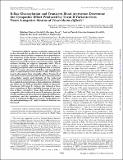| dc.contributor.author | Chaves-Olarte, Esteban | |
| dc.contributor.author | Freer, Enrique | |
| dc.contributor.author | Parra, Andrea | |
| dc.contributor.author | Guzman-Verri, Caterina | |
| dc.contributor.author | Thelestam, Monica | |
| dc.contributor.author | Moreno, Edgardo | |
| dc.date.accessioned | 2020-06-15T22:44:37Z | |
| dc.date.available | 2020-06-15T22:44:37Z | |
| dc.date.issued | 2003-03 | |
| dc.identifier.uri | http://hdl.handle.net/11056/17574 | |
| dc.description.abstract | Clostridium difficile induces antibiotic-associated di-arrhea through the production of toxin A and toxin B;the former toxin has been assumed to be responsible forthe symptoms of the disease. Several toxin A-negativestrains fromC. difficilehave recently been isolated fromclinical cases and have been reported to produce toxin Bvariants eliciting an atypical cytopathic effect. Ultra-structural analysis indicated these toxins induce arounding cytopathic effect and filopodia-like structures.Toxin B variants glucosylated R-Ras, and transfectionwith a constitutively active mutant of this GTPase pro-tected cells against their cytopathic effect. Treatment ofcells with toxin B variants induced detachment from theextracellular matrix and blockade of the epidermalgrowth factor-mediated phosphorylation of extracellu-lar-regulated protein kinases, demonstrating a deleteri-ous effect on the R-Ras-controlled avidity of integrins.Treatment with toxin B variants also induced a tran-sient activation of RhoA probably because of inactiva-tion of Rac1. Altogether, these data indicate that thecytopathic effect induced by toxin B variants is becauseof cell rounding and detachment mediated by R-Ras glu-cosylation, and the induction of filopodia-like struc-tures is mediated by RhoA activation. Implications forthe pathophysiology ofC. difficile-induced diarrhea arediscussed. | es_ES |
| dc.description.abstract | El Clostridium difficile induce la diarrea asociada a los antibióticos mediante la producción de la toxina A y la toxina B; se ha asumido que la primera toxina es la responsable de los síntomas de la enfermedad. Recientemente se han aislado varias cepas de la toxina A de C. difficile en casos clínicos y se ha informado de que producen variantes de la toxina B que producen un efecto citopático atípico. Los análisis ultraestructurales indicaron que estas toxinas inducen un efecto citopático circundante y estructuras similares a las filopodias. Las variantes de la toxina B glucosilada R-Ras, y la transfección con un mutante constitutivamente activo de esta GTPasa protegieron a las células contra su efecto citopático. El tratamiento de las células con variantes de la toxina B indujo el desprendimiento de la matriz extracelular y el bloqueo de la fosforilación mediada por el factor de crecimiento epidérmico de las proteínas cinasas reguladas por el extracto de lúpulo, lo que demostró un efecto deletéreo en la avidez de integrinas controlada por la R-Ras. El tratamiento con variantes de la toxina B también indujo una activación transitoria de la RhoA, probablemente debido a la inactivación de la Rac1. En conjunto, estos datos indican que el efecto citopático inducido por las variantes de la toxina B se debe al redondeo y desprendimiento de las células mediado por la cosilación de los glúcidos de R-Ras, y la inducción de estructuras similares a filopodios está mediada por la activación de RhoA. Se discuten las implicaciones para la fisiopatología de la diarrea inducida por C. difficile. | es_ES |
| dc.language.iso | eng | es_ES |
| dc.publisher | Universidad Nacional, Costa Rica | es_ES |
| dc.rights | Acceso abierto | es_ES |
| dc.rights.uri | http://creativecommons.org/licenses/by/4.0/ | * |
| dc.source | THE JOURNAL OF BIOLOGICAL CHEMISTRY Vol. 278, No. 10, March 7, pp. 7956 –7963, 2003 | es_ES |
| dc.subject | CLOSTRIDIUM DIFFICILE | es_ES |
| dc.subject | R-RAS GLUCOSYLATION | es_ES |
| dc.subject | TOXINAS | es_ES |
| dc.subject | TOXIN A | es_ES |
| dc.subject | TOXIN B | es_ES |
| dc.title | R-Ras Glucosylation and Transient RhoA Activation Determine the Cytopathic Effect Produced by Toxin B Variants from Toxin A-negative Strains of Clostridium difficile | es_ES |
| dc.type | http://purl.org/coar/resource_type/c_6501 | es_ES |
| dc.description.procedence | Escuela de Medicina Veterinaria | es_ES |
| dc.identifier.doi | 10.1074/jbc.M209244200 | |


